The submerged chain conveyor market is valued at USD 399.4 million in 2025 and is set to reach USD 715.2 million by 2035, with a CAGR of 6%. In the first five years (2021–2025), the market grows from USD 298.4 million to USD 399.4 million. This initial phase sees steady annual increments from USD 316.3 million in 2022, USD 335.3 million in 2023, USD 355.4 million in 2024, to USD 376.8 million in 2025. This growth is primarily driven by the expanding demand for submerged chain conveyors in sectors such as cement, steel, and power plants, where efficient material handling, waste treatment, and conveying systems are crucial. The adoption of advanced conveyor technologies, including energy-efficient and low-maintenance designs, also supports this steady rise in the market.
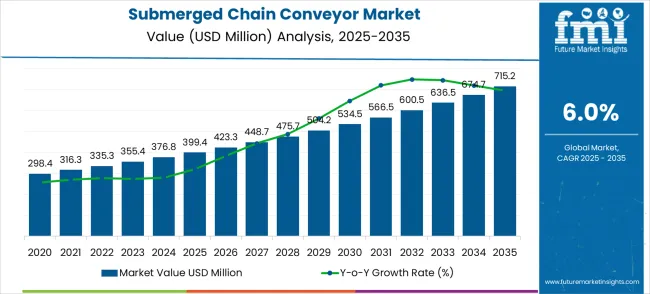
From 2026 to 2030, the market strengthens significantly, increasing from USD 399.4 million in 2025 to USD 534.5 million by 2030. Intermediate values during this period include USD 423.3 million in 2026, USD 448.7 million in 2027, and USD 475.7 million in 2028. Growth is driven by the increasing integration of automation in manufacturing processes, the adoption of submerged chain conveyors in new infrastructure projects, and the need for more efficient material handling in industries facing rapid urbanization and industrialization. The push toward replacing outdated equipment with more efficient systems also contributes to market growth.
| Metric | Value |
|---|---|
| Estimated Value in (2025E) | USD 399.4 million |
| Forecast Value in (2035F) | USD 715.2 million |
| Forecast CAGR (2025 to 2035) | 6% |
The material handling equipment market is the largest parent market, accounting for approximately 30-35% of the market share. Submerged chain conveyors are widely used for the transport of materials in industries such as mining, cement, and waste-to-energy, making this market critical to the overall demand. The waste management and recycling market contributes around 20-25%, as submerged chain conveyors are often employed in waste incineration plants, where they efficiently handle the movement of ash and other by-products. The steel manufacturing market plays a significant role, with about 15-20% of the market share, as submerged chain conveyors are used in steel plants for moving hot and abrasive materials like slag and steel billets.
The mining and minerals processing market accounts for approximately 10-15%, as submerged chain conveyors are commonly used in mining operations to transport heavy loads of minerals, ores, and other materials. The power generation market, contributing about 10-15%, relies on submerged chain conveyors in coal-fired power plants and waste-to-energy facilities for handling ash and other waste materials.
Market expansion is being supported by the increasing global demand for reliable power generation infrastructure and the corresponding need for robust material handling systems that can operate in high-temperature environments, ensure continuous ash removal, and maintain operational efficiency across various thermal power, waste incineration, and biomass processing applications. Modern power plant operators and industrial facility managers are increasingly focused on implementing conveying solutions that can handle abrasive materials, withstand extreme temperatures, and provide consistent performance in demanding operating conditions. Submerged chain conveyors' proven ability to deliver reliable material handling, operate in harsh environments, and support continuous plant operations makes them essential equipment for contemporary power generation and industrial processing facilities.
The growing focus on environmental compliance and operational efficiency is driving demand for submerged chain conveyors that can support effective waste handling, ensure reliable material transportation, and enable comprehensive ecological control. Power generation facilities' preference for material handling systems that combine durability with operational reliability and maintenance efficiency is creating opportunities for innovative submerged chain conveyor implementations. The rising influence of renewable energy integration and waste-to-energy technologies is also contributing to increased adoption of submerged chain conveyors that can provide reliable material handling without compromising operational efficiency or environmental performance.
The market is segmented by orientation, application, and region. By orientation, the market is divided into horizontal type, inclined type, and others. Based on application, the market is categorized into the thermal power industry, the waste incineration industry, biomass power generation, and others. Regionally, the market is divided into Asia Pacific, North America, Europe, Latin America, and the Middle East & Africa.
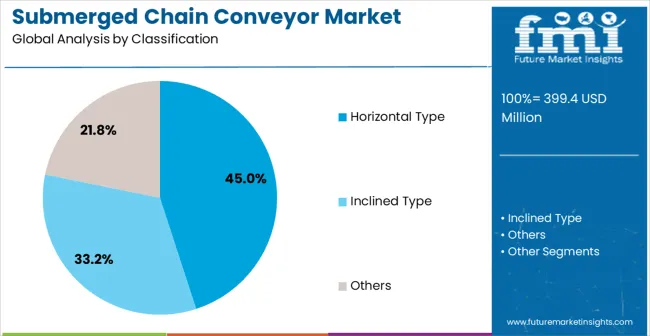
The horizontal type segment is projected to maintain its leading position in the submerged chain conveyor market in 2025, accounting for 45% of the total market share. This segment reaffirms its role as the preferred configuration for level material transportation and ash handling applications. Power plant operators and industrial facility managers increasingly utilize horizontal submerged chain conveyors for their straightforward installation requirements, reliable material flow characteristics, and versatility across various plant layouts and material handling scenarios. Horizontal conveyor technology’s proven effectiveness and operational simplicity directly address industrial needs for efficient material transportation and consistent performance in power generation and processing applications.
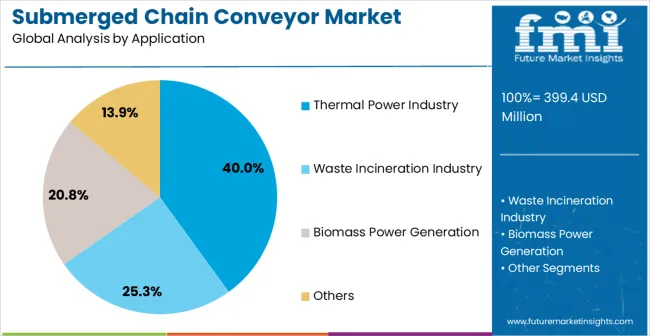
The thermal power industry application segment is expected to represent 40% of submerged chain conveyor demand in 2025, making it the largest sector for specialized conveyor adoption. Coal-fired power plants, gas-fired facilities, and combined-cycle operations all rely on submerged chain conveyors for effective ash handling due to their high-temperature operation capabilities, reliable material handling performance, and the ability to ensure continuous ash removal while maintaining plant efficiency and environmental compliance. Submerged chain conveyors are considered essential in modern thermal power operations, offering both operational advantages and reliability benefits.
The submerged chain conveyor market is advancing steadily due to increasing demand for reliable power generation infrastructure and growing adoption of specialized material handling technologies that provide enhanced operational efficiency and environmental compliance across diverse power generation and industrial processing applications. The market faces challenges, including high capital investment costs and installation complexity, maintenance requirements in harsh operating environments, and competition from alternative ash handling technologies and conveyor systems. Innovation in automation technologies and remote monitoring systems continues to influence product development and market expansion patterns.
The growing adoption of intelligent automation and remote monitoring technologies is enabling power plant operators to achieve superior operational control, predictive maintenance capabilities, and comprehensive system monitoring for enhanced facility management. Advanced automation systems provide improved operational efficiency while allowing more proactive maintenance scheduling and consistent performance monitoring across various conveyor installations and operating conditions. Manufacturers are increasingly recognizing the competitive advantages of automation integration for operational differentiation and facility optimization.
Modern submerged chain conveyor manufacturers are incorporating environmental compliance features and energy-efficient technologies to enhance operational performance, reduce environmental impact, and support comprehensive facility environmental management through optimized material handling and emission control systems. These technologies improve ecological performance while enabling new applications, including waste-to-energy integration and circular economy implementation. Advanced environmental integration also allows facilities to meet broader environmental compliance objectives beyond traditional material handling approaches.
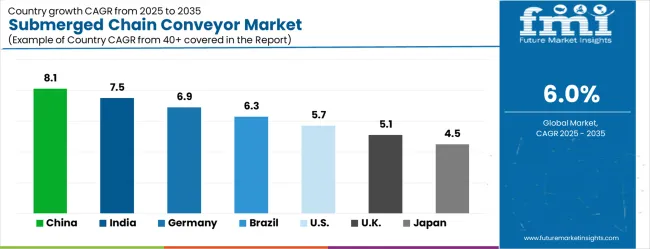
| Country | CAGR (2025-2035) |
|---|---|
| China | 8.1% |
| India | 7.5% |
| Germany | 6.9% |
| Brazil | 6.3% |
| USA | 5.7% |
| UK | 5.1% |
| Japan | 4.5% |
The submerged chain conveyor market is experiencing solid growth globally, with China leading at an 8.1% CAGR through 2035, driven by the expanding power generation infrastructure, growing industrial capacity, and significant investment in coal-fired power plants and waste-to-energy facilities development. India follows at 7.5%, supported by rapid power sector growth, increasing industrial development, and growing adoption of advanced ash handling systems in thermal power generation. Germany shows growth at 6.9%, emphasizing advanced engineering and precision conveyor technology development. Brazil records 6.3%, focusing on power infrastructure expansion and industrial modernization initiatives. The USA demonstrates 5.7% growth, supported by established power generation infrastructure and focus on facility modernization. The UK exhibits 5.1% growth, emphasizing power sector efficiency and environmental compliance technologies. Japan shows 4.5% growth, supported by advanced power generation technologies and precision material handling systems.
The report covers an in-depth analysis of 40+ countries with top-performing countries highlighted below.
India is projected to grow at a CAGR of 7.5% from 2025 to 2035 in the submerged chain conveyor market. The expanding industrial sectors, particularly in steel, cement, and power generation, are driving this demand. As India focuses on modernizing its manufacturing infrastructure, the need for efficient material handling systems like submerged chain conveyors is increasing. The government push to improve industrial capabilities and infrastructure is expected to further propel market growth. With the increasing energy demand and expansion in thermal and power generation plants, the requirement for advanced, energy-efficient conveyor systems is becoming more critical. As automation becomes a greater focus in Indian industries, submerged chain conveyors will play an essential role in improving operational efficiency.
The submerged chain conveyor market in China is set to grow at a CAGR of 8.1% from 2025 to 2035. The country’s position as a global manufacturing hub, especially in industries like steel and cement, is driving demand for efficient material handling systems. As China modernizes its industrial infrastructure and emphasizes automation, the need for advanced conveyor systems is increasing. The growing energy production, particularly in coal-fired power plants, also contributes to the rising demand for submerged chain conveyors in the power sector. With significant investments in smart factories and environmentally-friendly technologies, China is positioning itself as a leader in adopting efficient conveyor solutions. This focus on advanced technologies in industrial settings is expected to foster market growth for submerged chain conveyors.
Demand for submerged chain conveyor in Germany is growing at a CAGR of 6.9% from 2025 to 2035. As a global leader in industrial manufacturing, The demand for efficient material handling systems is being driven by its strong automotive, steel, cement, and power generation sectors. The continued focus on high-quality production standards and technological advancements has led to the increasing adoption of automated systems in manufacturing facilities. The focus on smart factories and Industry initiatives is also contributing to the market growth, as submerged chain conveyors are integral to improving operational efficiency and reducing downtime in industries. The growing industrial base, along with the country’s commitment to automation and energy savings, is expected to drive significant demand for submerged chain conveyors.
Brazil is experiencing steady growth in the submerged chain conveyor market, with an expected CAGR of 6.3% from 2025 to 2035. Brazil’s industrial sectors, particularly mining, steel production, and cement, are driving the demand for reliable conveyor systems. As the country continues to expand its industrial base and enhance manufacturing capabilities, there is a growing need for efficient and durable material handling systems. Brazil’s mining sector, one of the largest in the world, significantly contributes to the growth of submerged chain conveyors. The country’s push towards modernization of infrastructure and investment in power generation plants will also help drive market expansion.
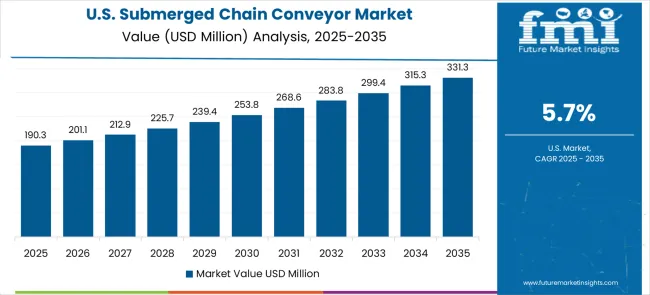
The submerged chain conveyor market in the United States is expected to grow at a CAGR of 5.7% from 2025 to 2035. The USA is witnessing steady demand from sectors like steel, cement, and power generation, where efficient material handling is critical. As the country focuses on improving its industrial capabilities and investing in infrastructure, submerged chain conveyors are becoming integral to manufacturing and power plants. The USA industrial sector’s focus on automation and operational efficiency further drives the need for advanced conveyor systems. The increasing demand for energy-efficient and durable systems in thermal power plants and cement industries is expected to support the market’s expansion.
The United Kingdom’s submerged chain conveyor market is projected to grow at a CAGR of 5.1% from 2025 to 2035. The UK’s focus on improving industrial efficiency and adopting automation technologies is driving demand for high-performance material handling systems. As industries such as steel, cement, and waste management expand, the need for submerged chain conveyors to support these operations is becoming more prominent. The UK’s growing focus on environmental standards and energy efficiency is pushing for the adoption of more energy-saving conveyor systems. The continued push towards Industry 4.0 and digital transformation in manufacturing processes is expected to further enhance the market’s growth.
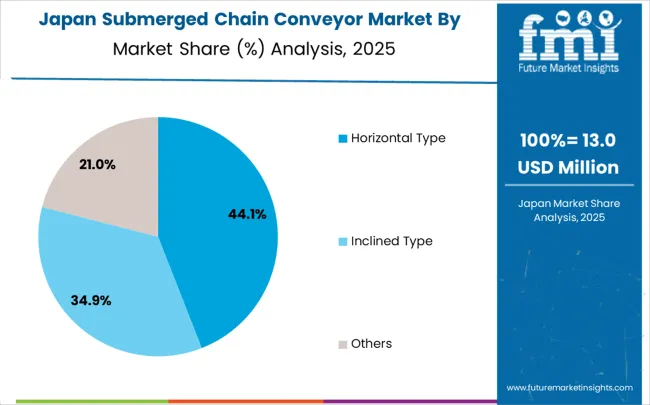
The submerged chain conveyor market in Japan is expected to expand at a CAGR of 4.5% from 2025 to 2035. The country’s heavy industries, including steel and cement production, are key drivers of this demand. Japan’s strong manufacturing base and focus on technological innovation are leading to greater automation and the need for high-performance material handling systems. As the country seeks to improve its industrial efficiency and invest in energy-efficient solutions, submerged chain conveyors are becoming an essential part of industrial infrastructure. The increasing focus on environmental responsible practices and reducing energy consumption is also expected to boost the demand for advanced conveyor systems.
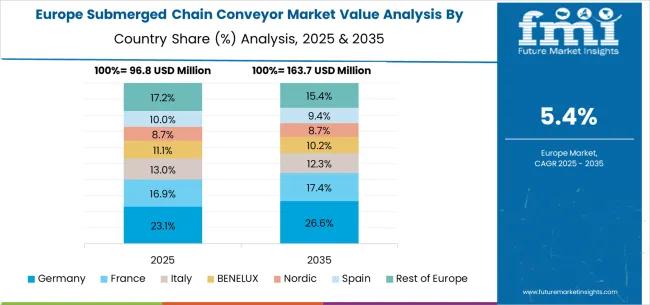
The submerged chain conveyor market in Europe is projected to grow from USD 148.3 million in 2025 to USD 252.8 million by 2035, registering a CAGR of 5.5% over the forecast period. Germany is expected to maintain its leadership position with a 27.0% market share in 2025, moderating slightly to 26.8% by 2035, supported by its strong power generation sector, advanced material handling technologies, and comprehensive industrial infrastructure serving major European markets.
The United Kingdom follows with 20.0% in 2025, projected to reach 19.8% by 2035, driven by established power sector efficiency focus, comprehensive environmental compliance framework, and advanced facility modernization programs. France holds 18.5% in 2025, rising to 18.7% by 2035, supported by power generation leadership and growing adoption of advanced material handling technologies. Italy commands 14.0% in 2025, projected to reach 14.1% by 2035, while Spain accounts for 9.0% in 2025, expected to reach 9.1% by 2035. The Netherlands maintains a 4.0% share in 2025, growing to 4.1% by 2035. The Rest of Europe region, including Nordic countries, Eastern Europe, and other markets, is anticipated to maintain its position, holding its collective share at 7.5% by 2035, attributed to increasing power infrastructure modernization and growing advanced material handling adoption across emerging energy markets implementing modern conveyor standards.
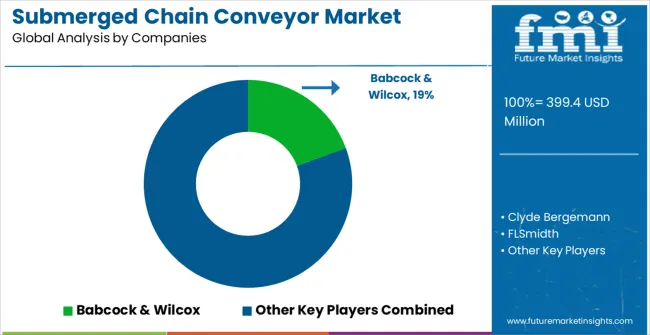
The submerged chain conveyor market is characterized by competition among established power generation equipment manufacturers, specialized material handling companies, and integrated industrial solution providers. Companies are investing in advanced conveyor technology research, engineering excellence, durability enhancement, and comprehensive product portfolios to deliver reliable, efficient, and durable submerged chain conveyor solutions. Innovation in automation technologies, environmental compliance features, and advanced chain designs is central to strengthening market position and competitive advantage.
Babcock & Wilcox Enterprises, Inc. leads the market with comprehensive power generation solutions, offering advanced submerged chain conveyors with a focus on operational reliability and high-temperature performance across diverse power generation applications. Clyde Bergemann provides specialized power plant equipment with an focus on ash handling systems and material transportation solutions. FLSmidth delivers innovative industrial equipment with a focus on the cement and power industries, with comprehensive material handling capabilities. UCC Environmental specializes in environmental solutions with focus on waste handling and material processing systems. Magaldi Power focuses on specialized conveyor technologies with focus on high-temperature applications and industrial processing. Bevcon Wayors offers comprehensive material handling solutions with a focus on reliability and operational efficiency.
Submerged chain conveyors represent a specialized heavy-duty material handling segment within power generation and industrial processing, projected to grow from USD 399.4 million in 2025 to USD 715.2 million by 2035 at a 6.0% CAGR. These robust conveyor systems-primarily horizontal configurations for ash handling-operate in high-temperature environments to transport abrasive materials in thermal power plants, waste incineration facilities, and biomass power generation applications. Market expansion is driven by increasing power generation capacity, growing demand for reliable ash handling systems, expanding waste-to-energy infrastructure, and rising focus on environmental compliance and operational efficiency in challenging industrial environments.
How Power Generation Authorities Could Enhance Infrastructure Standards and Environmental Compliance?
How Industrial Engineering Organizations Could Advance Technology Standards and Best Practices?
How Conveyor System Manufacturers Could Drive Innovation and Market Leadership?
How Power Plant Operators Could Optimize Material Handling and Operational Efficiency?
How Equipment Integration Partners Could Enable Comprehensive Plant Solutions?
How Investors and Financial Enablers Could Support Market Development and Infrastructure Growth?
| Items | Values |
|---|---|
| Quantitative Units (2025) | USD 399.4 Million |
| Orientation | Horizontal Type, Inclined Type, Others |
| Application | Thermal Power Industry, Waste Incineration Industry, Biomass Power Generation, Others |
| Regions Covered | Asia Pacific, North America, Europe, Latin America, Middle East & Africa |
| Countries Covered | China, India, Germany, Brazil, the United States, the United Kingdom, Japan, and 40+ countries |
| Key Companies Profiled | Babcock & Wilcox Enterprises, Inc., Clyde Bergemann, FLSmidth, UCC Environmental, Magaldi Power, and Bevcon Wayors |
| Additional Attributes | Dollar sales by orientation and application category, regional demand trends, competitive landscape, technological advancements in conveyor systems, automation development, environmental compliance innovation, and operational efficiency optimization |
Asia Pacific
North America
Europe
Latin America
Middle East & Africa
The global submerged chain conveyor market is estimated to be valued at USD 399.4 million in 2025.
The market size for the submerged chain conveyor market is projected to reach USD 715.2 million by 2035.
The submerged chain conveyor market is expected to grow at a 6.0% CAGR between 2025 and 2035.
The key product types in submerged chain conveyor market are horizontal type, inclined type and others.
In terms of application, thermal power industry segment to command 40.0% share in the submerged chain conveyor market in 2025.






Our Research Products

The "Full Research Suite" delivers actionable market intel, deep dives on markets or technologies, so clients act faster, cut risk, and unlock growth.

The Leaderboard benchmarks and ranks top vendors, classifying them as Established Leaders, Leading Challengers, or Disruptors & Challengers.

Locates where complements amplify value and substitutes erode it, forecasting net impact by horizon

We deliver granular, decision-grade intel: market sizing, 5-year forecasts, pricing, adoption, usage, revenue, and operational KPIs—plus competitor tracking, regulation, and value chains—across 60 countries broadly.

Spot the shifts before they hit your P&L. We track inflection points, adoption curves, pricing moves, and ecosystem plays to show where demand is heading, why it is changing, and what to do next across high-growth markets and disruptive tech

Real-time reads of user behavior. We track shifting priorities, perceptions of today’s and next-gen services, and provider experience, then pace how fast tech moves from trial to adoption, blending buyer, consumer, and channel inputs with social signals (#WhySwitch, #UX).

Partner with our analyst team to build a custom report designed around your business priorities. From analysing market trends to assessing competitors or crafting bespoke datasets, we tailor insights to your needs.
Supplier Intelligence
Discovery & Profiling
Capacity & Footprint
Performance & Risk
Compliance & Governance
Commercial Readiness
Who Supplies Whom
Scorecards & Shortlists
Playbooks & Docs
Category Intelligence
Definition & Scope
Demand & Use Cases
Cost Drivers
Market Structure
Supply Chain Map
Trade & Policy
Operating Norms
Deliverables
Buyer Intelligence
Account Basics
Spend & Scope
Procurement Model
Vendor Requirements
Terms & Policies
Entry Strategy
Pain Points & Triggers
Outputs
Pricing Analysis
Benchmarks
Trends
Should-Cost
Indexation
Landed Cost
Commercial Terms
Deliverables
Brand Analysis
Positioning & Value Prop
Share & Presence
Customer Evidence
Go-to-Market
Digital & Reputation
Compliance & Trust
KPIs & Gaps
Outputs
Full Research Suite comprises of:
Market outlook & trends analysis
Interviews & case studies
Strategic recommendations
Vendor profiles & capabilities analysis
5-year forecasts
8 regions and 60+ country-level data splits
Market segment data splits
12 months of continuous data updates
DELIVERED AS:
PDF EXCEL ONLINE
Submerged Drag Chain Conveyor Market Size and Share Forecast Outlook 2025 to 2035
Chain Conveyors Market Size and Share Forecast Outlook 2025 to 2035
Conveyor Belt Tracking Devices Market Size and Share Forecast Outlook 2025 to 2035
Conveyor Belt Market Size and Share Forecast Outlook 2025 to 2035
Conveyor System Market Size and Share Forecast Outlook 2025 to 2035
Conveyor Drives Market Analysis - Size, Share, and Forecast Outlook 2025 to 2035
Submerged ARC Furnaces Market Size and Share Forecast Outlook 2025 to 2035
Conveyor Dishwasher Market Size and Share Forecast Outlook 2025 to 2035
Conveyor Maintenance Industry Analysis in Australia - Size, Share, and Forecast Outlook 2025 to 2035
Conveyor Dryer Market Growth, Trends & Forecast 2025 to 2035
Conveyors and Belt Loaders Market Growth - Trends & Forecast 2025 to 2035
Conveyor Ovens & Impinger Ovens Market
Conveyor Belt Materials Market
UV Conveyor Systems Market
Cold Chain Logistics Transport Insulated Truck Market Size and Share Forecast Outlook 2025 to 2035
Blockchain Interoperability Market Size and Share Forecast Outlook 2025 to 2035
Blockchain Food Traceability Market Size and Share Forecast Outlook 2025 to 2035
Cold Chain Packaging Market Size and Share Forecast Outlook 2025 to 2035
Cold-Chain Sensor Encapsulators Market Analysis - Size and Share Forecast Outlook 2025 to 2035
Blockchain AI Market Size and Share Forecast Outlook 2025 to 2035

Thank you!
You will receive an email from our Business Development Manager. Please be sure to check your SPAM/JUNK folder too.
Chat With
MaRIA